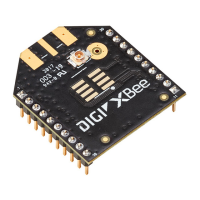Zigbee networks End device operation
Digi XBee® 3 Zigbee® RF Module
90
If the end device does not find a valid PAN, it performs the PAN scan on the next channel in its scan
channels list and continues this process until it finds a valid network, or until all channels have been
scanned. If the end device scan all channels and does not discover a valid PAN, it may enter a low
power sleep state and scan again later.
If scanning all SC channels fails to discover a valid PAN, XBee Zigbee devices attempt to enter a low
power state and retries scanning all SC channels after the device wakes from sleeping. If the device
cannot enter a low power state, it retries scanning all channels, similar to the router. To meet Zigbee
Alliance requirements, the end device attempts up to nine scans per minute for the first five minutes,
and three scans per minute thereafter.
Note The XBee Zigbee end device will not enter sleep until it has completed scanning all SC channels
for a valid network.
Join a network
Once the end device discovers a valid network, it joins the network, similar to a router, by sending an
association request (to the device that sent a valid beacon) to request a join on the Zigbee network.
The device allowing the join then sends an association response frame that either allows or denies the
join.
When an end device joins a network, it receives a 16-bit address from the device that allowed the join.
The device that allowed the join randomly selects the 16-bit address.
Parent child relationship
Since an end device may enter low power sleep modes and not be immediately responsive, the end
device relies on the device that allowed the join to receive and buffer incoming messages on its behalf
until it is able to wake and receive those messages. The device that allowed an end device to join
becomes the parent of the end device, and the end device becomes a child of the device that allowed
the join.
End device capacity
Routers and coordinators maintain a table of all child devices that have joined called the child table.
This table is a finite size and determines how many end devices can join. If a router or coordinator has
at least one unused entry in its child table, the device has end device capacity. In other words, it can
allow one or more additional end devices to join. Zigbee networks have sufficient routers to ensure
adequate end device capacity.
The initial release of software on this platform supports up to 20 end devices when configured as a
coordinator or a router.
In Zigbee firmware, use the NC command (number of remaining end device children) to determine
how many additional end devices can join a router or coordinator. If NC returns 0, then the router or
coordinator device has no more end device capacity.
Note Because routers cannot sleep, there is no equivalent need for routers or coordinators to track
joined routers. There is no limit to the number of routers that can join a given router or coordinator
device and no “router capacity” metric.
Authentication
In a network where security is enabled, the end device must then go through an authentication
process. For more information, see Zigbee security.

